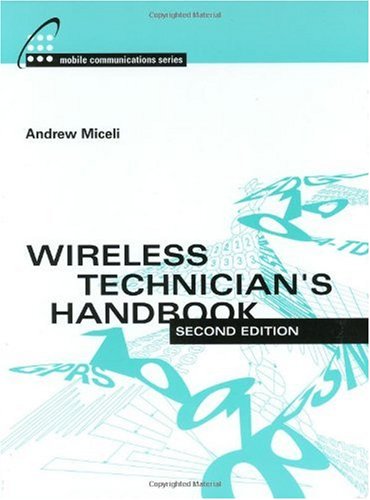Andrew Miceli9781580533577, 1580533574
Table of contents :
TeamLiB……Page 1
Cover……Page 2
Contents……Page 8
Foreword……Page 14
Acknowledgments……Page 16
1.2 Domains: Time and Frequency……Page 18
1.3 Power……Page 20
1.4 Understanding Propagation……Page 23
1.5 The Transmit and Receive Path……Page 26
1.6 Digital Basics……Page 28
1.7 Modulation……Page 32
1.8 Vocoding……Page 33
1.9 Shift Keying……Page 35
1.12 QPSK/O-QPSK and CDMA……Page 37
1.14 Spread Spectrum……Page 38
1.15 Conclusion……Page 39
2.2 The History of Cellular……Page 40
2.3 The ¡°Cell¡± in Cellular……Page 45
2.4 The Typical Modern Network……Page 48
2.5 The Concept of Multiple Access……Page 49
2.6 The Key to Truly Mobile Communications¡ªThe Handoff……Page 51
2.7 Sectorization……Page 53
2.8 Antennas……Page 54
2.9 Improving Performance……Page 56
2.10 Squeezing Out As Much As We Can¡ªRepeaters and Front Ends……Page 57
2.11 Systems in Use Around the Globe……Page 59
2.12 Conclusion……Page 62
3.2 The Analog Network……Page 64
3.3 Signaling on the Analog System……Page 65
3.4 Preparing Analog Signals……Page 68
3.5 Identifying the Mobiles and Base Stations……Page 70
3.7 Control and Voice Channels……Page 72
3.8 The FOCC……Page 73
3.9 The RECC……Page 77
3.10 The Voice Channels……Page 78
3.11 Call-Processing States……Page 80
3.12 Transmit Power……Page 81
3.13 The Handoff……Page 82
3.14 The Problems with AMPS……Page 84
3.15 Conclusion……Page 86
4.1 Introduction to NA-TDMA……Page 88
4.2 Nomenclature of NA-TDMA¡ªIdentifiers and Architecture……Page 89
4.3 Channels in NA-TDMA……Page 91
4.4 ¦Ð/4 DQPSK¡ªThe Modulation of NA-TDMA……Page 92
4.5 The FOCC, RECC, FVC, and RVC in IS-136……Page 94
4.6 The Digital Traffic Channel……Page 96
4.7 Messages on the DTCH……Page 99
4.8 The DCCH……Page 100
4.9 Sleep Mode……Page 102
4.10 Messages on the DCCH……Page 103
4.11 MAHO……Page 104
4.12 Authentication……Page 105
4.13 Conclusion……Page 109
5.1 Introduction……Page 110
5.2 GSM System Architecture……Page 111
5.3 Identifiers in GSM……Page 112
5.4 Modulation in GSM……Page 113
5.5 Power Levels……Page 114
5.6 GSM Channels……Page 115
5.7 Control Channels……Page 117
5.8 Vocoders and Traffic Channels……Page 119
5.9 Messaging……Page 121
5.10 Burst Types……Page 122
5.11 Frequency Hopping……Page 123
5.14 Stage 2 and Beyond……Page 124
5.15 Conclusion……Page 125
6.1 Introduction……Page 126
6.3 Packet Data Protocol Basics……Page 128
6.4 GPRS Phones and Devices……Page 129
6.5 Understanding the Layers……Page 130
6.6 GPRS Physical Channels……Page 131
6.7 GPRS Coding……Page 134
6.8 Bursts……Page 136
6.9 Channel Allocation……Page 137
6.10 Logical Channels……Page 139
6.11 Overview of GPRS Processes……Page 141
6.12 The EDGE Format……Page 142
6.13 8PSK Modulation and EDGE Coding……Page 143
6.14 EDGE and the Future……Page 144
7.3 Multiple Access in CDMA……Page 146
7.4 Capacity: The Reason for the Hype……Page 147
7.5 Understanding the ¡°Code¡± in CDMA……Page 148
7.6 The CDMA Vocoders……Page 150
7.7 The Forward Link¡ªCode Channels……Page 151
7.8 Synchronization on the Forward Link……Page 156
7.9 The Reverse Link Channels……Page 157
7.10 Power Control……Page 160
7.11 Call Processing¡ªThe Four States……Page 161
7.12 Registrations in CDMA……Page 162
7.13 Handoffs in CDMA……Page 163
7.14 The Pilot Searching Process……Page 164
7.15 Conclusion……Page 166
8.2 CDMA Evolution……Page 168
8.3 Overview of 1X-RTT and 3X-RTT……Page 169
8.4 Radio Configurations……Page 172
8.5 Spreading and Channel Coding Changes……Page 173
8.6 Air Interface Differences……Page 175
8.7 Power Control Changes……Page 177
8.8 Physical Channel Overview……Page 178
8.9 Forward Physical Channels……Page 180
8.10 Reverse Physical Channels……Page 184
8.11 Logical Channels and Layering Overview……Page 186
8.13 Forward Transmit Diversity……Page 187
8.15 Conclusion……Page 188
9.2 History of WCDMA……Page 190
9.4 TDD and FDD Modes……Page 192
9.5 Introduction to Nomenclature……Page 196
9.6 Slot and Frame Structure……Page 197
9.7 Logical and Transport Channels……Page 198
9.8 Physical Channels……Page 201
9.9 Spreading……Page 202
9.10 Synchronization……Page 205
9.11 Power Control……Page 206
9.12 Handovers in WCDMA……Page 207
9.13 Modulation……Page 209
9.15 Conclusion……Page 210
10.2 Types of Cellular and PCS Technicians……Page 212
10.3 Introduction to the Radio Transceiver……Page 214
10.4 Measuring Power……Page 217
10.5 Time and Frequency Error Measurements……Page 220
10.6 Spectrum Analysis……Page 221
10.7 Scalar Network Analysis……Page 225
10.8 Testing the Audio and Mechanical Components……Page 226
10.10 Introducing the Communications Test Set……Page 227
10.11 Drive Test Tools……Page 228
10.12 The Battery……Page 229
10.13 Conclusion……Page 230
11.2 The AMPS Receiver……Page 232
11.4 Testing the AMPS Receiver……Page 234
11.6 Testing the AMPS Transmitter……Page 238
11.7 Conclusion……Page 241
12.2 Introduction to the TDMA Transceiver……Page 242
12.4 Functional Tests……Page 245
12.5 Transmitter Tests……Page 247
12.6 Receiver Tests……Page 251
12.8 Testing Data¡ªGPRS and EDGE……Page 256
12.9 Conclusion……Page 257
13.1 Introduction……Page 258
13.3 Introduction to CDMA Tests……Page 259
13.4 Testing Power……Page 261
13.5 Code-Domain Tests (BTS Only)……Page 266
13.6 Timing, Frequency, and Modulation Testing……Page 270
13.8 Out-of-Band Tests……Page 272
13.9 Receiver Tests……Page 273
13.10 1X and Beyond……Page 274
13.11 Conclusion……Page 275
14.2 Transmission Tests……Page 276
14.4 Conclusion……Page 277
Appendix A……Page 280
Appendix B……Page 282
Glossary……Page 284
Selected Bibliography……Page 294
About the Author……Page 296
Index……Page 298

Reviews
There are no reviews yet.